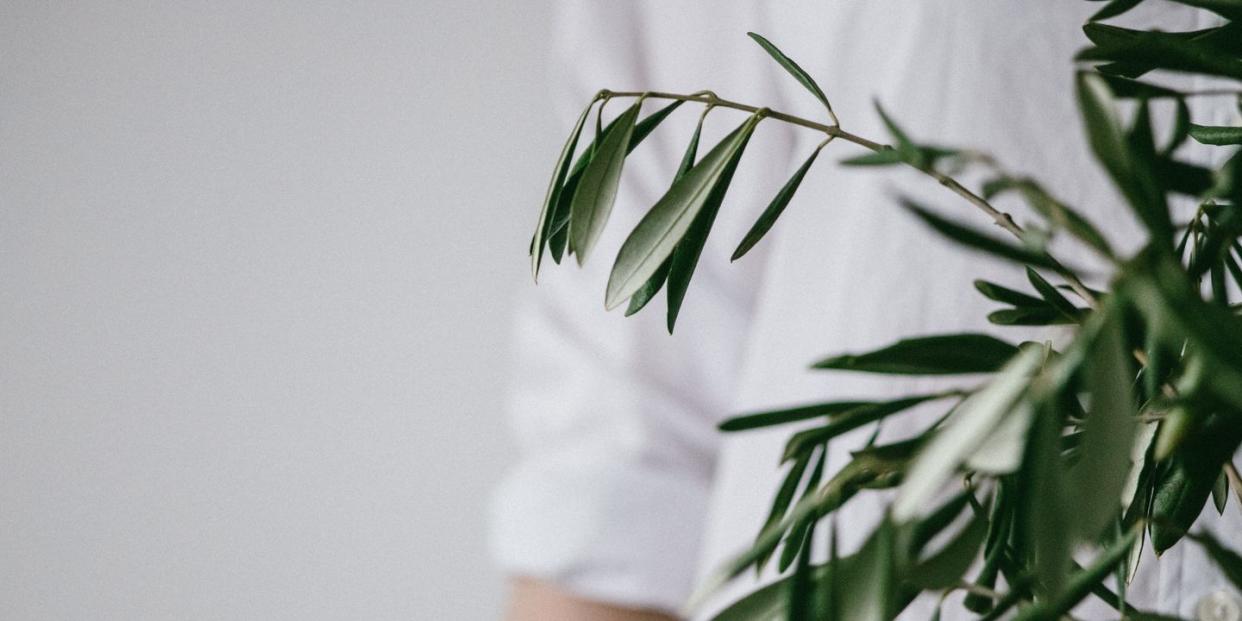7 Secrets for Keeping an Indoor Olive Tree Alive

Prized for their shiny, green foliage and interesting forms, olive trees are a fun and fairly easy plant to dress up your brightest windows. “It’s actually not a difficult plant to grow if you have lots of light,” says Georgia Clay, new plants manager with Monrovia. “They look both rustic and modern at the same time so they’re great in many different settings.” If you're looking for a new and interesting houseplant, these are great tabletop plants or small trees to add to your collection.
Here’s what you need to know to keep your indoor olive tree healthy and beautiful:
What kind of light does my indoor olive tree need?
Sun, sun, and more sun! After all, they’re natives of the Mediterranean’s hot, dry climate. “They require six or seven hours of sunlight to thrive, so put them in your sunniest window, preferably south-facing,” says Clay. If you don’t have enough hours of sunlight—which is entirely possible if you live much of the country, especially in the wintertime—get a small standard LED grow light to help your plant out.
How often should I water my olive tree?
“They’re used to drought, so let them dry out in between waterings,” says Clay. Keeping them soggy will kill them! Check the moisture level by pushing a finger into the soil. If it feels damp, wait a few days and check again. When you do water, give it a good long drink so water flows all the way down to the roots. Also, make sure there are holes in the bottom of the pot. No plant likes wet feet!
How often should I feed my olive tree?
Olive trees benefit from regular doses of fertilizer. Use a typical houseplant food, feeding twice a month during its growing season in the spring and summer, once a month in the fall, and maybe once in the winter, if you like. “It’s actually ‘sleeping,’ not growing in the winter, so it really doesn’t have to have food,” says Clay.
Should I repot my olive tree?
When you first bring it home, you don’t have to repot your tree, though you can place the nursery pot into a larger decorative pot. They’re typically slow growers if they live indoors all year round. In time, if it appears like the root ball is filling up the entire pot, or you’re watering and it’s not penetrating the soil, it may be time to repot, says Clay. Go up one pot size or just a few inches larger. If you try to jump up to too big of a pot, that will lead to soggy soil, which these plants despise. Use a sandy soil to repot, such as a cactus mix.
Do olive trees attract pests?
They are hardy and seldom have issues with pests, although you may occasionally see scale, a type of sucking insect that leaves white deposits on the leaves and a scale-y looking substance on the stems. “It’s not hard to control if you apply a horticultural oil or insecticidal soap according to label instructions at the first signs of a problem,” says Clay.
Can I get olives from my indoor olive tree?
You can purchase a few different types of olive trees. Some are “fruiting” and bear olives, but only if they get sufficient sunlight—which is tough to do indoors. The fruiting types, such as Arbequina, also need a period of chilling temperatures to stimulate flowering and set fruit. Non-fruiting varieties, such as ‘Little Ollie,’ tend to stay bushier and more compact.
Should I take my indoor olive tree outside for summer?
It would probably love a trip outdoors, says Clay. Do it gradually once the nighttime temperatures are 50 degrees or warmer. Start slowly by putting it out for an hour or two per day and keeping it the shade at first so it doesn’t fry. Gradually increase the time outdoors and amount of direct sunlight over a few weeks. Bring it indoors for the winter when nighttime temps drop below 50 again.
You Might Also Like

